HTC was once a dominant source of Android phones until Samsung took the lead with the Galaxy series of devices. It can be such simple ideas and changes that make or break how successful a phone can be. Mobile phones are so advanced today it’s hard for designer to distinguish their product from the competition. Can HTC accomplish this with the HTC One M8?
Over the last couple of years HTC went stale and lost their way. HTC had some of the first iPhone challengers available and then they just seemed to lose their touch. It was clear HTC needed a reboot and this is what they did with the original HTC One.
The original HTC One had a few distinct differences. They created a solid uni-body designed phone built from a single, machined piece of aluminum. They moved the speakers to the front of the device with Boomsound, which in my opinion was one of their best moves ever. They also changed the camera to use a lower pixel resolution and enhanced the software to do wonderful things with it. Their claim was most people don’t use their mobile devices as a camera replacement, but instead they use them as a device to post pictures onto social networks and for showing on the screen of the phone, so why have a mega pixel camera.
The main feature of the HTC One was the design and build of the phone.  They came up with a process for making the majority of the body from a solid piece of aluminum machined to insert the innards required for the phone. The end result was a beautifully crafted piece of art that anyone would be proud to carry around. It felt solid and looked beautiful.
Continuing on the award winning success of the HTC One, HTC created the HTC One M8. There is the obvious DNA of the previous model with more aluminum and curves and rounded edges, better sounding speakers, and more enhancements to the low resolution camera. The results are nothing short of perfection, or are they?
Specs
HTC has increased the specs of the HTC One M8 to include the latest and greatest components.  The processors is the latest Qualcomm Snapdragon MSM8974ABv3 2.3 GHz Snapdragon 801 MSM8974ABv3 clocked at 2.3 GHz.  the screen has been increased to a 5″ 1080p LCD display. The battery has been increased to 2600 mAh and HTC has still found space to include a microSD card slot.
One interesting upgrade is the increase in resolution of the front facing camera to 5MP for super sharp selfies.  That’s more resolution than the 4MP found in the rear facing camera.  Selfie shots and video chat are crystal clear so kudos to HTC for this enhancement.
Size:Â 146.36 x 70.6 x 9.35 mm
CPU Speed: 2.3 GHz Qualcomm® Snapdragon™ 801, quad-core CPUs
Memory:Â Total storage: 16GB/32GB, available capacity varies
RAM: 2GB
Expansion: Expansion card slot supports microSDâ„¢ memory card for up to 128GB additional storage (card not included)
Rear Duo camera
Primary camera: HTC UltraPixelâ„¢ camera , BSI sensor, pixel size 2.0 um, sensor size 1/3â€, f/2.0, 28mm lens
HTC ImageChip 2. 1080p Full HD video recording with HDR video
Secondary camera: capture depth information
Front camera
5MP, BSI sensor, wide angle lens. with HDR capability, 1080p Full HD video recording
Gallery with UFocusâ„¢, Dimension Plusâ„¢, Seasons, Foregrounder, Image match
Weight:Â 160g
Display:Â 5.0 inch, Full HD 1080p
Battery: 2600 mAh Embedded rechargeable Li-polymer battery
Talk time:Â Up to 20 hours for 3G
Standby time:Â Up to 496 hours for 3G
More details can be found on the HTC One M8 Information Page.
Build
HTC had a hit with the HTC One and now had a choice to make for its next flagship device. Was the HTC One so successful that trying to make a sequel to it would not have the required effect of a new device or create a new phone that was somehow different and an obvious leap in their device evolution!
The HTC One M8 is a clear sequel to an already proven and successful design, but it’s enhanced in all the right places that makes it a clear step up from the previous HTC One.
The tooling process has been improved even further for the HTC One M8 with the body made from 90% metal, which is an increase from the previous HTC One’s 70% metal. The results are immediately obvious from your first glance at the device, screaming quality compelling you to look twice.
If you walked into a store and browsed through the latest round of devices, I guarantee that after looking at every device, you’d go back to the HTC One M8 as the obvious choice in the high end design of phones. This includes the very well design iPhone 5. It’s just done right and looks incredible.
Due to the size increase and more metal, it does weight more than most other devices, weighing in at about 160gms makes it feel stronger and feels like you’re getting more phone for your dollars.
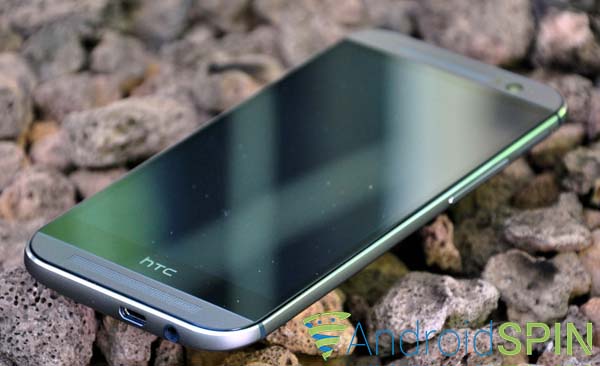
Some people have argued that the inclusion of the front facing Boomsound speakers has increased the length of the device too much, but as soon as you hear what sound they can produce, how can you argue that it was a wrong decision. Â Even with the increase in size, I still find myself being able to use the HTC One M8 one handed for the majority of tasks.
The gentle curves take the rear of the phone around to the front bezel without a single break or plastic edging. The subtle lines across the top and bottom of the back neatly breaking up the brushed aluminum. Every little detail oozes with quality.
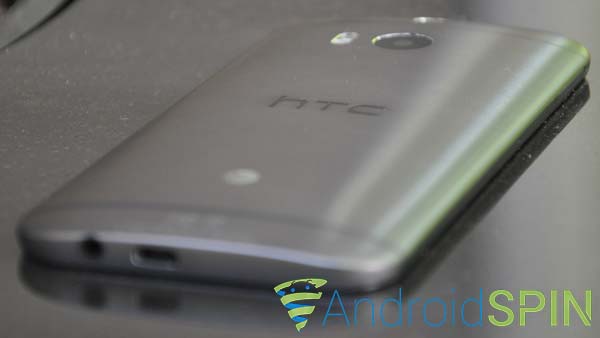
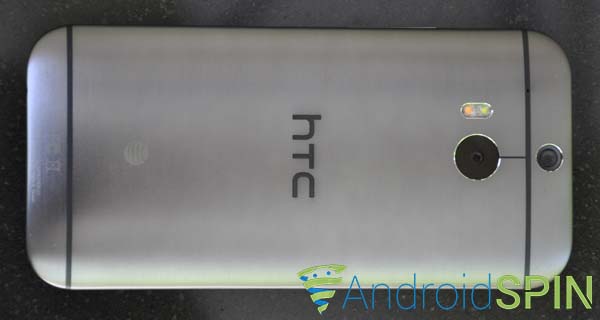
When you pick up the HTC One M8 it feels solid and comfortable. The curves just fit perfectly in your hand and the lack of sharp edges are welcome. The designers obviously paid a lot of attention to detail and in my opinion created something that has very little room for change.
You’ll find the usual button selection around the HTC One M8. On the top you’ll find the Power button on the same surface as the IR transmitter used if you want to control your home audio and video equipment.

The bottom edge is the location of the USB/Power port and the 3.5mm headphone socket.

On the left you’ll find a single slot for the nanoSIM card.

Moving around to the right you’ll find the volume rocker and the MicroSd card slot.

Size wise, the phone has increased over the original HTC One to support the larger screen.  It’s about as long as my Samsung Note 2 but little narrower.  the actual size is 146.36 x 70.6 x 9.35mm.

The end results make the HTC One M8 clear competition for any Samsung Galaxy phone, iPhone, or other Android device.
One downside to the uni-body design is the fixed battery.  to make this design work and keep size to a minimum, HTC had to make the battery not removable.  We all know that batteries do not the charge as well over time.  With the average life span of a device being about 2 years, this could become a problem after a while.  As many providers are now offering better and shorter contract options, people will probably upgrade more frequently so this may be a mute point, but a changeable battery would have been preferred.
Camera
The camera is where HTC has made enhancements over is predecessor.  Looking on the back of the HTC One M8 you’ll find two camera lenses known as the Duo Cam.  No it’s not falling victim of the 3D camera fad that appeared on the EVO 3D. The second lens is actually a depth capturing device.
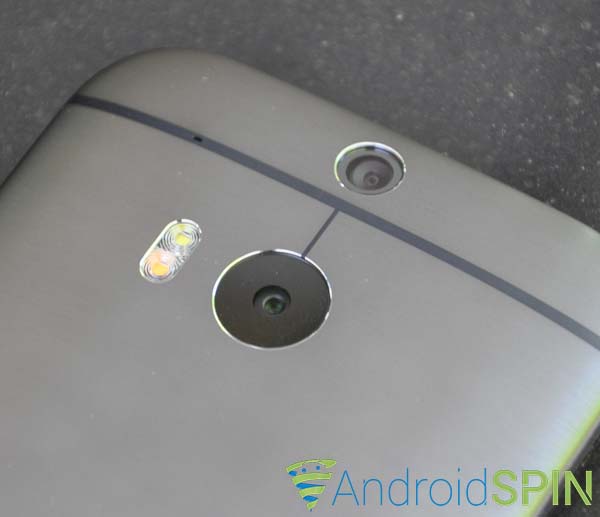
The second camera lens captures a lower resolution secondary image and some depth information that allows you to perform some post picture taking magic. Â The main lens is still the ULTRAPIXEL that HTC used in the original HTC One.

The camera software has been enhance to make your lives easier. Â when you in the camera, a quick swipe across your screen in either switch between the front and rear cameras. Â a single tap on your screen sets your focus point for the shot, while holding down on the screen sets the focal point and locks the light and focus to that point, which can be used to create some focus based effects.
Touching the small mode icon brings up your camera mode selections including Selfi, Camera, Dual capture, Video, Pan 360 and Zoe Camera.
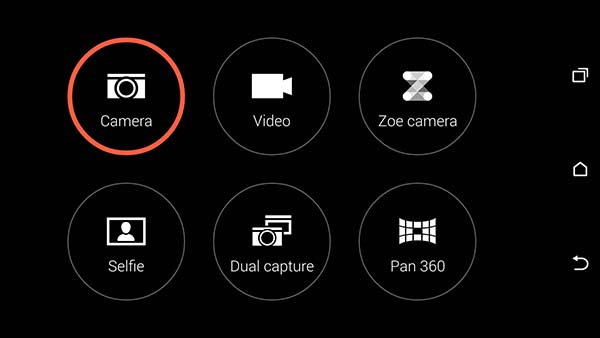
Taking a photo with the regular rear facing Duo Cam then allows you to perform all forms of adjustments and tweaks. Â the camera UI is simple and pleasant to use and makes it easy to navigate and select the options you need. Â The live preview is very fast and as long as the light is good. Â dropping down a darker scenes does slow down the live preview, but this is to be expected as the camera works harder to give you a better picture.
The lag when taking a picture is almost non existent and makes capturing photos a delight.  Burst capture is also fast at about 12fps and using the best shot option automatically composes the best picture it can and then deletes the rest.
One nice addition over the original HTC One is the dual flash for better in door and party shooting.
Once you’ve got your shot captured, this is where you can start to perform the many functions only the HTC One M8 with it’s Duo Cam allows.
UFOCUS is probably the best camera tool ever included in a mobile phone. Â UFOCUS allows you to change the focus point of any image capture with the Duo Cam after you’ve taken the photo. this give you images that look like a professional photographer would take using the depth controls of a modern day DSLR. Â The effect is amazing and would have previously taken a lot of time processing using tools like Photoshop.
While this tool works great, it does occasionally have issues determining which subjects to focus on so other foreground objects can also be left on focus instead just the subject your trying to enhance. Â It’s very minor and the tools is still amazing.
Foregrounder is another effect that you can use that tries to add a kind of shadowing effect to everything except the object you touched on the screen.  Is pretty cool, but not as dramatic as the UFOCUS tool.
The next tool is Seasons, which is really a bit of gimmick in that it allows you add seasonal effect to your photos, such as snow flakes or dandelions blowing around.
Dimension plus allows you to adjust the angle of your photo parallax style. Â It’s like a 3D effect that give the impression of viewing your photo from different angles as you adjust the angle of your phone.
Stickers is a fun tool that allows you to add stickers such as hats, mustaches, etc to photos for that fun factor of making you or your friends look silly.
The other camera modes are pretty self explanatory.
Video lets you take video clips in glorious high Definition, but it’s not as good as the original HTC One. Â for some reason HTC decide to leave out Optical Image Stabilization (OIS). Â Probablt due to cost concerns, but it’s a shame as OIS does help capture better less blurry pictures.
ZOE is unfortunately non existent at the moment. Â Launching the ZOE software of the HTC One M8 I have for review brings up a screen saying Coming Soon.
Selfi will switch to the front facing camera, lets you take photos of yourself and then make adjustments to improve the picture.
Capture a picture with the Duo Cam, head into the effects software and you presented with a list of cool effects available only to the HTC One M8.
all in all the camera does take great photos, but I can’t get over the lower resolution of the ULTRAPIXEL lens. Â Many times I’ll take a photo and want to crop and zoom in when I’m done. Â The difference is evident when you do this on the lower resolution images produced by the HTC One M8.
Software / Sense 6.0
There is always debate around OEMs adding their own skins to the Android OS.  HTC added sense almost from day one of Android devices.  In the early days this was a great addition and made Android much more usable and prettier.  as Android has matured so has its interface and it off the shelf usability is leaps and bounds above what it used to be.  so do we need an OEM skin such as Sense on top of Android anymore?
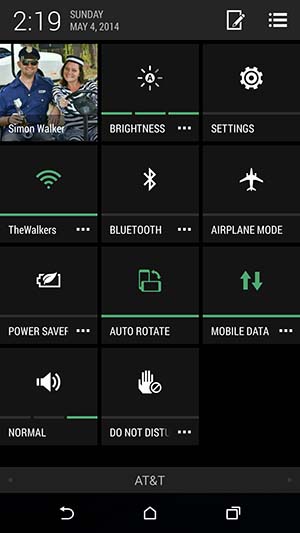 Â
 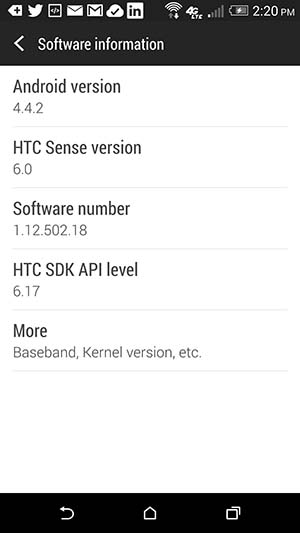
The answer for skins on Android is really down to personal preference. Â If there was a skin that I’d want to use, it would be sense 6.0. Â Sense has come a long way. Â it used to overwhelming to the point that you really didn’t know you where running Android. Â As it progressed over the years, HTC has slimmed it down to a point where it’s very usable and dos not hinder your Android experience. Â Again, this is my opinion and everyone is going to be different.
Scrolling to the left reveals HTC’s Blinkfeed. Â Blinkfeed is the product that goes out to all your social networks, news sources and more and bring it all under one umbrella is a tidy scrolling interface. Â The previous version of Blinkfeed was a little limited in the number of sources you could choose from, but that’s been addressed in the new version included with Sense 6.0.
Want to switch to a different look and feel? Â Head into the theme area and choose a few nicely done picture and color themes to personalize your HTC One M8 experience. Â HTC has always done a nice job of their keyboard as well. Â It still works well in regular typing and swyping mode
 Â
 
Most of the Sense 6.0 UI elements have a flatter more modern look than previous versions. Â Bouncing and scrolling effects from previous versions have gone as HTC adopt a more AOSP look and feel. Â All in all it’s a nice tone down from previous versions and makes the whole experience on the HTC One M8 very pleasant.
Motion
With usability in Mind, HTC decided to add a number of motion sensitive launch controls.  Available in the HTC One M8 are a number of motion detected gestures that are used to wake up the device and perform certain actions as soon as the HTC One M8 wakes up.  There are a number of motions available, but the two that caught my attention were the double tapping of the screen to wake up, similar to the LG G2 and the instant camera launch by holding the HTC One M8 in landscape orientation and holding down the volume button.
It’s nice to see OEMs finding ways to enhance their device, even when they do start copying each other. Â As they continue to pick out all the good parts from their competitors, we are the ones who benefit.
Screen
HTC has generally released phones with good screen. They have stuck with the LCD style for the HTC One M8.  they tend to use a little more power that AMOLED screens used by the likes of Samsung but the color can be a little cleaner with better contrast levels.  this is the same with the HTC One M8.  the screen does appear to be a little brighter than the screen used on the original HTC One, but it’s always hard to tell when you don’t have them side by side.
Outdoor clarity is good even in bright sunlight. Â It’s never going to be perfect, but it’s usable.
Performance
What I can say about performance except its excellent. Â With all the latest flagship phones running quad core, octa-core and whatever else with speeds in excess of 2Ghz, what else would you expect. Â Every single operation I performed on the HTC One M8 was flawless. Â I never experienced any lag changing screens or launching applications. Â I could run a whole slew of benchmarks and post the results but they exist in every corner of the Internet. Â Day to day use of this flagship device is flawless. Â Games look wonderful and sound amazing. Â Movies and other videos are bright and clear. Â I’m not sure how much more performance our phones can take. Â We are already at the point where our phones are as powerful as our desktop computers so the manufacturers should stop adding bigger processors and start looking at better ways to utilize them.
Call Quality
Its funny how call quality sometimes gets neglected when people look at modern smartphones.  It is still a phone you know.  Carrier constantly enhance their networks, compress data to save bandwidth and many of the adjustments and network enhancements can affect your call quality.
The HTC One M8 has amazing front facing speakers the product the best sound you’ve ever heard in a smartphone, but hows the microphone?  Well I’m pleased to say that all the test calls I made and people I asked agree that my voice was generally loud and clear.  I’m on the AT&T network and quality is normally good in our area so it’s fairly easy to get a good test of the call quality of a phone.
I compared the call quality of the HTC One M8 to my friends Samsung Galaxy S5, also on AT&T, and from my own experience the HTC One M8 sounded clearer and less muffled.  Admittedly this was only a couple of calls for comparison, but that was my opinion.
Using the HTC One M8 as a speaker phone also produced good results.  This is obviously due to the excellent speakers on the front of the HTC One M8, I could hear everyone else loud and clear.  Its been a while since I was happy using a smartphone as a speaker phone without any additional Bluetooth devices to enhance the sound.  This makes the HTC One M8 a great device for business use.
Battery
No matter what I did to this phone during a regular day, the battery always lasted and that’s all I need. Â As long as I never have to worry about my phone battery dying during each day, i know I can get home and put my phone on charge before going to bed. Â HTC seem to have got that part right on the HTC One M8. Â the original HTC One would not last a day for me with heavy usage ad this one does.
It is a shame that the battery is not removable and I’m sure if this was my device, it would start to suffer eventually. Â Would It suffer before I was ready for a new device, who knows, but at least I would have the choice.
Conclusion
Amazing. Â I love the HTC One M8. Â It feels great and is build like a tank. Â It’s not water resistant or dust resistant like other newer phones coming on to the market, but I’ve never had an issue with either of those. Â I guess I have used my phone in light rain and had to be cautious about it getting wet, but that doesn’t happen often.
I would have no hesitation in recommending anyone looking for a new device take the HTC One M8 into consideration over just about anything else on the market.












